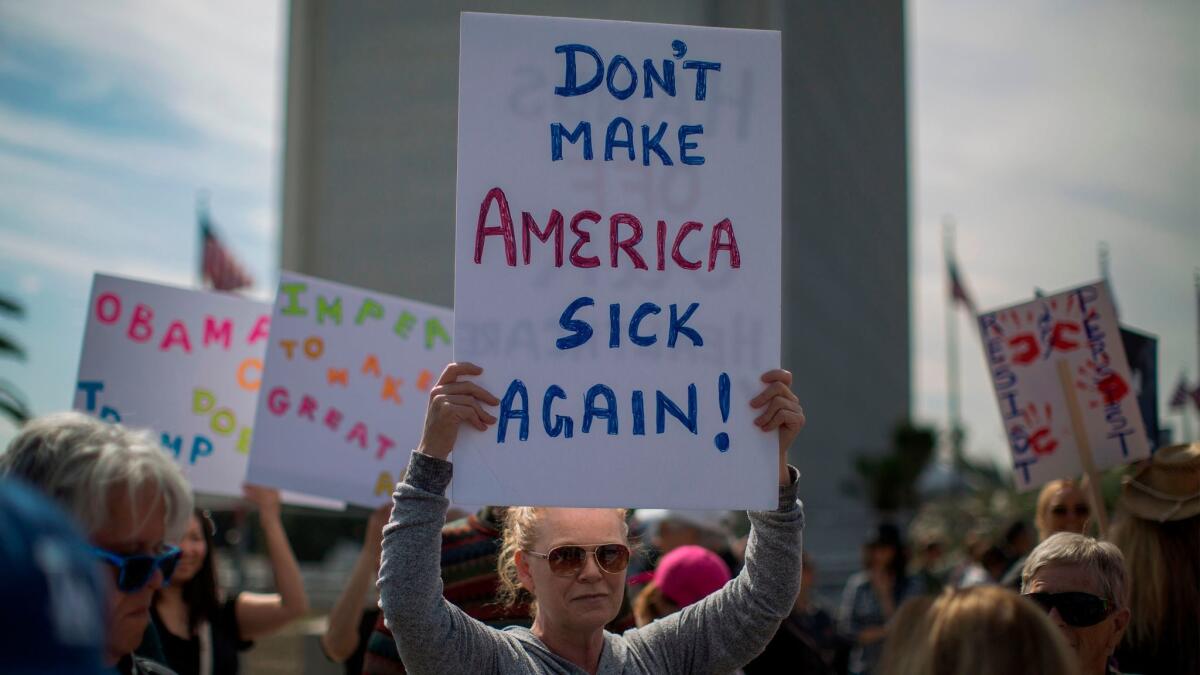Opinion: Threatening to take away their care at gunpoint isn’t the way to get Medicaid recipients working

According to the Trump administration, having a job makes you healthier.
Most people — especially those who aren’t coal miners, air traffic controllers or professional football players — would agree with that. So it’s not unreasonable for the federal government to encourage states to try to get more of their able-bodied Medicaid recipients into jobs. In fact, it’s something Medicaid has been doing for some time with disabled Americans.
The question, though, is how to increase the number of Medicaid recipients who are employed. On Thursday, the administration invited states to experiment with a coercive approach: cutting off benefits to low-income residents who don’t find a job (or, possibly, a “community engagement” gig, such as a training program or volunteer work). Such experiments may begin soon — 10 states already have sought permission from the federal government to impose work requirements on Medicaid recipients.
One of the main problems with a work requirement is the risk it poses to the people it’s not designed to reach.
The move feeds into a damaging stereotype of low-income Americans as parasites who ride the taxpayers’ backs. In fact, says Judy Solomon of the left-leaning Center on Budget and Policy Priorities, the vast majority of those who would be subject to a state’s work requirements either already are working or are sidelined by illness, disability or advanced age. Many of the rest are either in school or caring for a dependent child.
Of the remaining 9%, Solomon said, about two-thirds couldn’t find work and the rest aren’t working for some other reason. There are plenty of things states could do to try to push those enrollees into jobs or training programs, but threatening every able-bodied Medicaid recipient’s benefits hardly seems like the right way to go about it.
Jeff Myers, chief executive of Medicaid Health Plans of America — the trade association for insurers that operate Medicaid managed care plans in California and 39 other states — argues that safeguards in the Trump administration’s new guidelines will stop states from abusing their new flexibility. For one thing, states won’t be able to win approval for a pilot program just by showing that the work requirements will reduce enrollment and save money. They have to show that the requirements will improve enrollees’ health. For another, Myers noted that the guidelines bar states from imposing work requirements on many of their Medicaid recipients, including pregnant women, people being treated for opioid addiction and adults caring for ailing dependents.
“There are lots of people to whom applying a work requirement is not a good idea,” Myers said. “We view the population of individuals who could actually fit into a work requirement is relatively small.”
So why go that route? “I think it goes back to how states view the value of work for populations that may not have had experience like most have had,” Myers said.
One of the main problems with a work requirement, though, is the risk it poses to the people it’s not designed to reach. Solomon said that some portion of the Medicaid enrollees who are supposed to be exempt or who meet the requirements will lose their coverage because of paperwork problems. Also, states can’t be counted on to help low-income residents surmount the barriers they face to working, such as their need for child care, transportation and training. That’s been one of the lessons of federal welfare reform: States were good at imposing limits on benefits, but not so good at providing the programs that made it possible for poor people to hold a job.
Consider Kentucky’s proposed experiment with a work requirement. The state projects that by the fifth year, about 100,000 fewer people per month would receive Medicaid. The reduction would represent a huge success if it stemmed from all those people finding jobs that pulled them out of poverty. But the expectation is that those enrollees would simply fail to work (or get job training or volunteer) the required number of hours. That’s why the experiments contemplated by the new guidelines violate the law, Solomon said — they would cause states to deny Medicaid to people whom Congress deemed eligible.
A second, fundamental problem is that cutting off insurance to people will only make it harder for states to bring their healthcare costs under control. Medicaid has shifted toward managed care in an attempt to keep enrollees healthier, treat ailments earlier and do a better job managing chronic conditions. All of those cost-saving techniques go out the window when people move from Medicaid to no insurance. These former enrollees will still get care, but it will come when they are sicker and costlier to treat. And the price will still be paid by taxpayers and those with private coverage.
So yes, by all means — help more Medicaid recipients obtain jobs. But don’t do so by holding their coverage at gunpoint.
Twitter: @jcahealey
More to Read
A cure for the common opinion
Get thought-provoking perspectives with our weekly newsletter.
You may occasionally receive promotional content from the Los Angeles Times.







